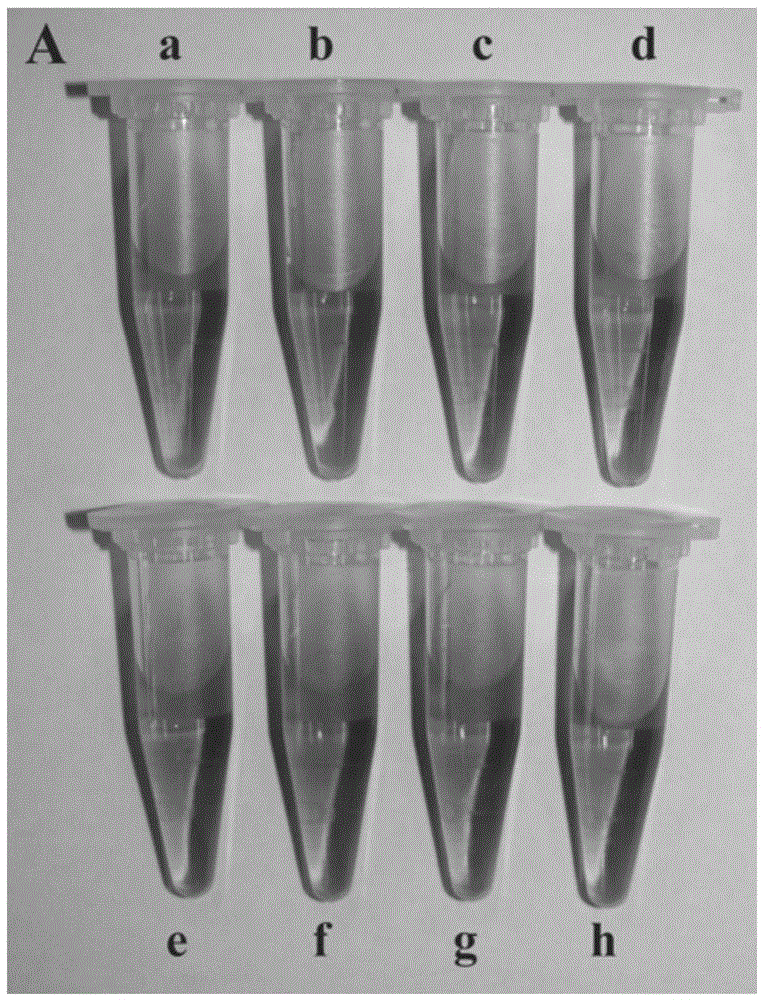Gold nanoparticle-containing glucose visual detection sensor and its preparation method and use
A glucose sensor and gold nanoparticle technology, which is applied in the direction of analyzing materials through chemical reactions and analyzing materials through observing the impact on chemical indicators, can solve problems such as interference detection results and agglomeration
- Summary
- Abstract
- Description
- Claims
- Application Information
AI Technical Summary
Problems solved by technology
Method used
Image
Examples
preparation example Construction
[0019] The invention provides a method for preparing a gold nanoparticle visual detection glucose sensor, which is characterized in that, comprising:
[0020] 1) carry out contact reaction with chloroauric acid and trisodium citrate in solvent to obtain gold colloidal solution;
[0021] 2) Adjust the pH of the gold colloid solution to 6.0-7.5, then add 3-aminophenylboronic acid (APBA) and amino-terminated poly-N-isopropylacrylamide (PNIPAM-NH 2 ) for electrostatic interaction to prepare a gold nanoparticle visual detection glucose sensor.
[0022] In step 1) of the present invention, the specific type of solvent can be selected in a wide range, but considering cost, preferably, the solvent is deionized water.
[0023] In step 1) of the present invention, the consumption of each substance can be selected in a wide range, but in order to improve the productive rate of gold nanoparticles, preferably, with respect to the water of 100 weight parts, the consumption of chloroauric a...
Embodiment 1
[0032] 1) Prepare the gold colloid solution according to the method described in "FrensG.Controllednucleationfortheregulationoftheparticlesizeinmonodispersegoldsuspensions[J].Nature, 1973,241(105):20-22.": first use aqua regia (HCl: HNO 3 =3:1, volume ratio) to clean and remove impurities, rinse with deionized water, and dry naturally for use; then add 5mLHAuCl 4 (0.01mol / L) was added to 100mL of deionized water, magnetically stirred evenly; then the resulting solution was heated to reflux (100°C), and then 5mL of trisodium citrate solution (1% by weight) was quickly added to the above solution. It was observed that the color of the solution changed from colorless to purple and finally to wine red within a few minutes. Continue heating for 30 minutes to obtain a uniform citric acid stable gold colloid solution. Remove the heating device, cool at 25°C, and store in a sealed container. Store in a refrigerator at 4°C.
[0033] 2) At 25°C, take 0.5mL of gold colloid solution and ...
Embodiment 2
[0035] The sensor A2 was prepared according to the method of Example 1, except that the pH was adjusted to 6.0 in step 2).
PUM
 Login to View More
Login to View More Abstract
Description
Claims
Application Information
 Login to View More
Login to View More - R&D
- Intellectual Property
- Life Sciences
- Materials
- Tech Scout
- Unparalleled Data Quality
- Higher Quality Content
- 60% Fewer Hallucinations
Browse by: Latest US Patents, China's latest patents, Technical Efficacy Thesaurus, Application Domain, Technology Topic, Popular Technical Reports.
© 2025 PatSnap. All rights reserved.Legal|Privacy policy|Modern Slavery Act Transparency Statement|Sitemap|About US| Contact US: help@patsnap.com



